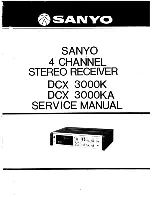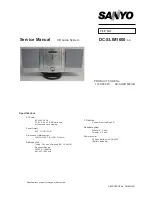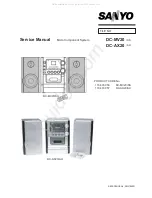
© 2003 TDM Audio, Inc.
Graphic Equalizer Owner’s Manual
Page 8
Hooking Up the Equalizer
nce your TDM equalizer is installed in the rack, you are ready to hook it up to your
equipment. The method used to hook up any equalizer depends on how it will be used. We
will try to give you the basics in this manual, but you may need to tailor the methods
described here to your particular application.
What You’ll Need
To connect your 15GE-2 equalizer to your equipment, you will need the following.
•
Power:
A power outlet should be located close enough to the unit so that you can plug it
in. The 15GE-2 equalizers require a grounded (3-prong) outlet. If an outlet is not close
enough, an extension cord or power strip may be used. Check the power rating on the
extension cord or power strip to make sure that it exceeds the power requirements of all
units plugged into it combined. TDM units have their power requirements marked on the
rear of the unit.
•
Signal Cables:
You need one cable to connect your signal source to the input of each
equalizer channel that you will be using, and one cable to connect each equalizer output
to your crossover or amplifier input.
The Basic Hook-Up
Plug the power cord that emerges from the back of the unit into an electrical outlet capable of
supplying the correct voltage, current, and frequency. This information is printed on the rear
panel of your TDM 15GE-2 equalizer.
Before connecting the equalizer signal cables, make sure that any power amplifiers are off or
their input levels are all the way down.
The normal way to connect an equalizer is between your sound signal source and your limiter,
crossover or amplifier. For each channel, the output of the signal source is fed into the equalizer.
The equalizer output is then connected to the input of the limiter, crossover, or amplifier. If you
are using a limiter, the equalizer goes before it in the chain. Otherwise the output of the equalizer
feeds the input of the crossover (in a multi-amped system) or the power amplifier (in a passive
system).
Instrument Equalization
To equalize a specific signal source such as an instrument or vocal at the mixing console, insert
the equalizer into the signal path at the instrument’s channel on the console. Consult the
documentation for your mixing console to determine the proper way to do this.
If the equalizer will be used at the signal source (in the instrument rack, for example), then there
are many possible ways to connect it. You will need to experiment to determine the best
configuration for your needs. Generally, equalizers are inserted in the signal path—they are not
usually used in an effects loop. They are usually inserted after an instrument or microphone
preamp, and they most often go before compressors or limiters. They can go before or after
O


































